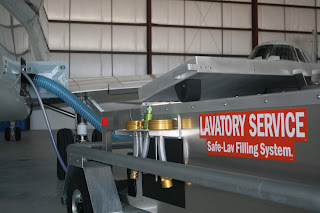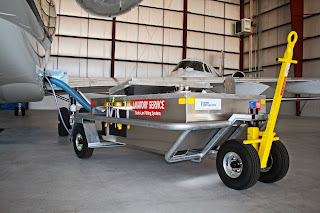How to Increase Safety for Airport Ground Crews During Extreme Weather
Aviation ground crew work comes with some risks. It requires working
from heights to clean, deice, repair, fuel, or otherwise maintain
aircraft, typically at a fast pace. It also involves working in and
around a whole fleet of motorized ground support equipment and heavy
lifting, not to mention working with often dangerous, caustic, and
highly flammable chemicals. And all of that is happening while there are
massive aircraft taxiing around or being towed by aircraft tugs—it’s a pretty busy work environment.
Despite all of that, most members of an air side crew wouldn’t have it any other way. There is, however, an additional risk: Extreme weather. It’s getter hotter in the summer, harsher in the winter, and the storms during the seasons can be more severe. These factors all create a dynamic that is not only miserable for an air side crew, it can be dangerous. Fortunately, the following safety tips can help to reduce that risk.
Planning and Updating
The first step in addressing severe weather is setting up a plan for dealing with it. If there is already a plan for severe weather, ensure that it is updated and that any equipment involved is fully functional and optimized for performance.Also ensure that all ground crew are familiar with the procedures such as places to take shelter, warning communication systems, specific protocols, check-in and communication standards, etc.
Warning System
Speaking of warning communications systems, ground crew work generally involves conditions impeding the crew’s ability to hear. It’s hard to hear a warning siren or a cell phone beeping with a storm warning when an aircraft tow tractor is rumbling by and a jet engine is roaring. A strobe light is among the most popular of solutions, so consider employing one (if you’re not already), or adopting some other other visual warning system.
Working in the Cold
Wear layers: The more layers, the more warmth and more ability to regulate temperature if the temperature rises. Ensure that the clothing fits well also. Too loose and the clothing isn’t great at keeping you warm and can more easily be snagged; too tight and circulation is restricted as well as movement. Covering extremities is big: Cover and keep your ears, hands, and feet warm and protected from the cold. Gloves should be thick with durable construction and high-quality materials. Boots should be warm, as waterproof as possible, and have good tread to prevent slips and accidents. Cold, wet feet are uncomfortable, distracting, and can be dangerous. It’s best to be bundled up properly so the focus stays primarily on the work rather than the temps.
Working in the Heat
Of course, working in extreme heat can be just as dangerous as working in the bitter cold. In some ways it can be even more dangerous.Heat stroke can result in significant injuries and even death. Particularly when that work involves exertion like air side ground crew labor. No matter the weather, but especially in the heat of summer, it’s important to stay hydrated. Ensure easy access to water, plenty of it, and urge the importance of staying hydrated as to avoid dehydration or heat stroke. Sunscreen is also important. If the job site provides trailers with air conditioning, use them as often as necessary. And despite the heat, the key to keeping as cool and protected from the sun as possible is covering up. That means wearing sunscreen, a hat, sunglasses, and a light, long-sleeved shirt and pants.
And no matter the temps, be sure to have ground crew wearing the appropriate gear to make sure they’re noticed on and off the tarmac. Bright, reflective vests, lights, and reflective strips on clothing can help keep everyone safe and aware of where ground crew is working. While some of these tips are more general, it’s the basics that can be easy to forget in the day-to-day rush on particularly cold and hot days. Proper training is essential as well as ensuring everyone has what they need to do their job effectively—particularly in extreme weather.
About AERO Specialties
AERO Specialties is well-known as one of the standard-setting thought leaders in aviation equipment and ground support equipment (GSE) quality and innovation. Their GSE is recognized as some of the best on the market due to their commitment to cutting-edge technological advancement in the aviation industry. AERO Specialties’ dedication to providing the best GSE available is shared by their entire team. They ensure that their whole staff—from sales to support—receive in-depth training on all GSE and the responsibilities of the airside ground crews. From their aircraft ground power unit line to aviation safety equipment, AERO Specialties has everything your aviation business needs to take off.
Learn more about helping your business take flight with AERO Specialties’ GSE and training resources, at Aerospecialties.com
Despite all of that, most members of an air side crew wouldn’t have it any other way. There is, however, an additional risk: Extreme weather. It’s getter hotter in the summer, harsher in the winter, and the storms during the seasons can be more severe. These factors all create a dynamic that is not only miserable for an air side crew, it can be dangerous. Fortunately, the following safety tips can help to reduce that risk.
Planning and Updating
The first step in addressing severe weather is setting up a plan for dealing with it. If there is already a plan for severe weather, ensure that it is updated and that any equipment involved is fully functional and optimized for performance.Also ensure that all ground crew are familiar with the procedures such as places to take shelter, warning communication systems, specific protocols, check-in and communication standards, etc.
Warning System
Speaking of warning communications systems, ground crew work generally involves conditions impeding the crew’s ability to hear. It’s hard to hear a warning siren or a cell phone beeping with a storm warning when an aircraft tow tractor is rumbling by and a jet engine is roaring. A strobe light is among the most popular of solutions, so consider employing one (if you’re not already), or adopting some other other visual warning system.
Working in the Cold
Wear layers: The more layers, the more warmth and more ability to regulate temperature if the temperature rises. Ensure that the clothing fits well also. Too loose and the clothing isn’t great at keeping you warm and can more easily be snagged; too tight and circulation is restricted as well as movement. Covering extremities is big: Cover and keep your ears, hands, and feet warm and protected from the cold. Gloves should be thick with durable construction and high-quality materials. Boots should be warm, as waterproof as possible, and have good tread to prevent slips and accidents. Cold, wet feet are uncomfortable, distracting, and can be dangerous. It’s best to be bundled up properly so the focus stays primarily on the work rather than the temps.
Working in the Heat
Of course, working in extreme heat can be just as dangerous as working in the bitter cold. In some ways it can be even more dangerous.Heat stroke can result in significant injuries and even death. Particularly when that work involves exertion like air side ground crew labor. No matter the weather, but especially in the heat of summer, it’s important to stay hydrated. Ensure easy access to water, plenty of it, and urge the importance of staying hydrated as to avoid dehydration or heat stroke. Sunscreen is also important. If the job site provides trailers with air conditioning, use them as often as necessary. And despite the heat, the key to keeping as cool and protected from the sun as possible is covering up. That means wearing sunscreen, a hat, sunglasses, and a light, long-sleeved shirt and pants.
And no matter the temps, be sure to have ground crew wearing the appropriate gear to make sure they’re noticed on and off the tarmac. Bright, reflective vests, lights, and reflective strips on clothing can help keep everyone safe and aware of where ground crew is working. While some of these tips are more general, it’s the basics that can be easy to forget in the day-to-day rush on particularly cold and hot days. Proper training is essential as well as ensuring everyone has what they need to do their job effectively—particularly in extreme weather.
About AERO Specialties
AERO Specialties is well-known as one of the standard-setting thought leaders in aviation equipment and ground support equipment (GSE) quality and innovation. Their GSE is recognized as some of the best on the market due to their commitment to cutting-edge technological advancement in the aviation industry. AERO Specialties’ dedication to providing the best GSE available is shared by their entire team. They ensure that their whole staff—from sales to support—receive in-depth training on all GSE and the responsibilities of the airside ground crews. From their aircraft ground power unit line to aviation safety equipment, AERO Specialties has everything your aviation business needs to take off.
Learn more about helping your business take flight with AERO Specialties’ GSE and training resources, at Aerospecialties.com




Comments
Post a Comment